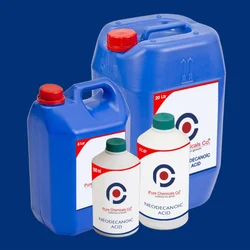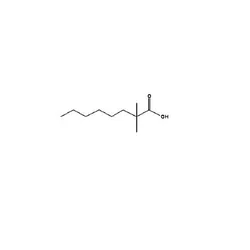Neodecanoic acid
- CAS NO.:26896-20-8
- Empirical Formula: C10H20O2
- Molecular Weight: 172.26
- MDL number: MFCD16855768
- EINECS: 248-093-9
- SAFETY DATA SHEET (SDS)
- Update Date: 2025-07-14 15:27:00

What is Neodecanoic acid?
Description
Neodecanoic acid is used primarily as an intermediate to make other chemical products. For example, a metal salt of neodecanoic acid can be used in various applications, such as paint driers, polyvinylchloride stabilizers, or polymerization initiators. Ester derivatives of neodecanoic acid are used in surface coatings and cement additives. In its neutralized form, neodecanoic acid is used in metalworking fluids. Neodecanoic acid is a liquid with a relatively low vapor pressure; however, elevated temperatures and mechanical action may form vapors, mist, or fumes. The material should be handled only with adequate ventilation and in areas where ignition sources have been removed (e.g., open flames, static electricity sources, unprotected light switches).
Chemical properties
Clear, colorless liquid in 97% purity; available commercially.
The Uses of Neodecanoic acid
2,2,3,5-Tetramethylhexanoic Acid is used in analytical studies as a method to quantitatively determine the total organic acid content in aqueous coolant.
Definition
Its derivatives are especially effective as paint driers and are being widely used. Applications as plasticizers and lubricants are also possible.
General Description
Colorless liquid.
Air & Water Reactions
Dust explosion is possible [USCG, 1999]. Water insoluble.
Reactivity Profile
Neodecanoic acid is a carboxylic acid. Carboxylic acids donate hydrogen ions if a base is present to accept them. They react in this way with all bases, both organic (for example, the amines) and inorganic. Their reactions with bases, called "neutralizations", are accompanied by the evolution of substantial amounts of heat. Neutralization between an acid and a base produces water plus a salt. Carboxylic acids in aqueous solution and liquid or molten carboxylic acids can react with active metals to form gaseous hydrogen and a metal salt. Such reactions occur in principle for solid carboxylic acids as well, but are slow if the solid acid remains dry. Even "insoluble" carboxylic acids may absorb enough water from the air and dissolve sufficiently in Neodecanoic acid to corrode or dissolve iron, steel, and aluminum parts and containers. Carboxylic acids, like other acids, react with cyanide salts to generate gaseous hydrogen cyanide. The reaction is slower for dry, solid carboxylic acids. Insoluble carboxylic acids react with solutions of cyanides to cause the release of gaseous hydrogen cyanide. Flammable and/or toxic gases and heat are generated by the reaction of carboxylic acids with diazo compounds, dithiocarbamates, isocyanates, mercaptans, nitrides, and sulfides. Carboxylic acids, especially in aqueous solution, also react with sulfites, nitrites, thiosulfates (to give H2S and SO3), dithionites (SO2), to generate flammable and/or toxic gases and heat. Their reaction with carbonates and bicarbonates generates a harmless gas (carbon dioxide) but still heat. Like other organic compounds, carboxylic acids can be oxidized by strong oxidizing agents and reduced by strong reducing agents. These reactions generate heat. A wide variety of products is possible. Like other acids, carboxylic acids may initiate polymerization reactions; like other acids, they often catalyze (increase the rate of) chemical reactions.
Health Hazard
Irritating to eyes and respiratory tract in high concentrations. May cause hair disorder or damage.
Fire Hazard
Special Hazards of Combustion Products: Flammable toxic gas may be released, if thermally decomposed.
Flammability and Explosibility
Flammable
Toxicology
Neodecanoic Acid has been adequately studied and is generally recognized to have low acute toxicity if ingested and/or breathed. Concentrations (above 25mg/m3 ) in the air can cause eye, nose, throat, and lung irritation in humans. It is not regarded as a mutagen, a carcinogen, or a concern for reproductive, developmental, or nervous system toxic effects.
Properties of Neodecanoic acid
| Boiling point: | 243-253°C |
| Density | 0.92 |
| vapor pressure | 2Pa at 24.85℃ |
| refractive index | 1.4192 (estimate) |
| Flash point: | 122 °C |
| storage temp. | Sealed in dry,Room Temperature |
| solubility | Chloroform (Slightly), Methanol (Slightly) |
| form | liquid |
| color | colorless |
| Water Solubility | 79.7mg/L at 20℃ |
| InChI | InChI=1S/C10H20O2/c1-10(2,3)8-6-4-5-7-9(11)12/h4-8H2,1-3H3,(H,11,12) |
| CAS DataBase Reference | 26896-20-8(CAS DataBase Reference) |
| NIST Chemistry Reference | Neodecanoic acid(26896-20-8) |
| EPA Substance Registry System | Neodecanoic acid (26896-20-8) |
Safety information for Neodecanoic acid
| Signal word | Warning |
| Pictogram(s) |
 Exclamation Mark Irritant GHS07 |
| GHS Hazard Statements |
H412:Hazardous to the aquatic environment, long-term hazard |
| Precautionary Statement Codes |
P273:Avoid release to the environment. |
Computed Descriptors for Neodecanoic acid
| InChIKey | YPIFGDQKSSMYHQ-UHFFFAOYSA-N |
| SMILES | C(C)(C)(C)CCCCCC(=O)O |
Neodecanoic acid manufacturer
Triveni Interchem Private Limited (Group Of Triveni Chemicals)
New Products
4,4-Difluoropiperidine hydrochloride tert-butyl 9-methoxy-3-azaspiro[5.5]undecane-3-carboxylate Indole Methyl Resin N-Isopropylurea N,N-Dicyclohexylcarbodiimide(DCC) MELDRUMS ACID 5-METHYLISOXAZOLE-4-CARBOXYLIC ACID Magnessium Bis glycinate Zinc ascorbate 1-bromo-2-butyne 2-acetamidophenol 9(10H)-anthracenone Erythrosin B, 4-Piperidinopiperidine 2-((4-morpholinophenylamino) (methylthio) methylene) malononitrile 2,4-dihydroxybenzaldehyde 3-(4-morpholinophenylamino)-5-amino-1H-pyrazole-4-carbonitrile Methyl 2-methylquinoline-6-carboxylate 2,6-dichloro-4-nitropyridine 4-Bromo-2-chlorobenzonitrile 2-(benzylamino)acetic acid hydrochloride 4-(tert-Butoxycarbonylamino)but- 2-ynoic acid 3,4-dihydro-2H-benzo[b][1,4]dioxepine 1-Phenyl-1-cycloprppanecarboxylicacidRelated products of tetrahydrofuran








You may like
-
 Neo-decanoic acid 98.00% CAS 26896-20-8View Details
Neo-decanoic acid 98.00% CAS 26896-20-8View Details
26896-20-8 -
 Neo-decanoic acid 95% CAS 26896-20-8View Details
Neo-decanoic acid 95% CAS 26896-20-8View Details
26896-20-8 -
 Liquid Neo Decanoic AcidView Details
Liquid Neo Decanoic AcidView Details
26896-20-8 -
 Liquid Neodecanoic AcidView Details
Liquid Neodecanoic AcidView Details
26896-20-8 -
 Liquid Neodecanoic Acid, Packaging Type: DrumView Details
Liquid Neodecanoic Acid, Packaging Type: DrumView Details
26896-20-8 -
 Neodecanoic Acid C10H20O2View Details
Neodecanoic Acid C10H20O2View Details
26896-20-8 -
 20677-73-0 (2,2-diethoxyethyl)methylamine 98%View Details
20677-73-0 (2,2-diethoxyethyl)methylamine 98%View Details
20677-73-0 -
 3-(4-(hydroxyamino)-1-oxoisoindolin-2-yl)piperidine-2,6-dione 98%View Details
3-(4-(hydroxyamino)-1-oxoisoindolin-2-yl)piperidine-2,6-dione 98%View Details
